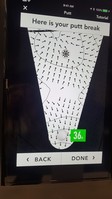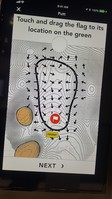


In 2018, there are some significant improvements in golf products, and, as usual, there’s a proverbial plethora of products to help golfers get better at the game.
This season brings more trampoline for the driver and fairway woods, hot orange and yellow golf balls and so many other colors you could match them to outfits. There’s a mini TrackMan-like device you can afford, tablets that read your putting stroke and shoes that measure your weight transfer. It’s technological craziness. It’s ideas gone wild.
With THE PLAYERS Championship this weekend, here are a few of those new products you may find in your nearest pro shop or online after the tournament inspires you to improve your game.
Bring the High Heat
Let’s start with the new trampolining driver, and its cousins, the fairway wood and hybrid, called High Heat 257+( www.knuthgolf.com).
We mentioned High Heat last year, but this new design might be the biggest thing in golf you’ll never hear about because High Heat doesn’t have a big advertising budget like TaylorMade or Callaway.
The new High Heat 257+ takes advantage of a measurement change the USGA made for different parts of the club face, according to Dean Knuth, inventor of High Heat clubs. Instead of just defining trampolining for the center of the club, the USGA now allows more trampolining for the heel and toe.
This is big because, let’s face it, how often do average golfers actually hit the center of the face of the driver or their fairway woods? Almost never. So, they don’t get the benefit or power of a center hit. They never know where the ball is going to hit on the clubface. Average golfers just hope for contact.
Now, Knuth is no stranger to golf or the USGA regulations. He was a senior executive at the USGA, and he created the slope system in golf. Immediately, he was christened the Pope of Slope. But after he left the USGA, he started High Heat.
When Knuth saw this regulation change, he went, “Aha!” He understood what it meant and what benefit it could provide for golfers. Then he went to work on a titanium clubface that has three separate bouncy parts instead of one. It’s like three trampolines, one in the center area, and an even bouncier part for the toe and heel. But it’s one seamless face. It’s a breakthrough in engineering and materials know-how.
The result? More measurable bounce off the entire clubface for the driver, the fairway wood and the hybrid, particularly the heel and toe hits. It’s something designed specifically for the average golfer who specializes in off-center hits. It puts more oomph in the effort.
The way the USGA previously measured the clubface bounce or trampoline effect was Coefficient of Restitution or COR, but they changed it to Characteristic Time, which gives a measurement in microseconds.
To put it in simpler language, High Heat 257+ has 257 CT in the center of the club and 266 CT on the heel and toe surfaces because the USGA now allows it. That’s significantly more than other golf clubs. More is now ok, and more is preferred.
Unfortunately, you can’t go to the PGA Superstore or Edwin Watts to buy or test High Heat. You can get them online, but it might be worth a drive over to The Villages where High Heat does several demo days each year. You can test hit and then decide. The driver is $499, the fairway wood is $329 and the hybrid is $227. For more information, visit www.knuthgolf.com.
Track ball flight for less
While the High Heat clubface is an innovation in clubface design, there’s a new, modestly priced ball flight tracker that provides information on shots and mimics the abilities of TrackMan.
A tad larger than a garage door opener, this new device tracks the golf ball and provides information on carry distance, clubhead speed, ball speed, vertical launch angle, spin, height and flight time. And it can transmit the data to a phone or tablet. If a golfer takes video of his/her swing, it can superimpose the data onto that.
It’s called mevo, it’s made by FlightScope and it costs $499.
Until now, this kind of technology had cost around $2,500 and went up to $15,000. TrackMan goes for $19,000 for an indoor version and $25,000 for outdoors.
With mevo, golfers pair their phone or tablet to the mevo device using the app. A golfer puts a sticker on the ball, hits and moments later, mevo can spit out stats on the screen with video of that swing.
mevo uses doppler radar to measure the clubhead and the ball separately. The mevo device fits in a pocket or purse and has a handy, flip out stand so one can set it up nearly anywhere.
For more information, visit https://www.flightscopemevo.com/#works.
A ball with a chip?
OnCore, the company that made the ball with the hollow metal core, is getting ready to put a chip inside a ball that supposedly can be used for on-course play.
It will have a Bluetooth communications device inside that will communicate with a phone. The company plans to call it Genius. OnCore is trying to crowdsource the money to build more of them, and the company currently anticipates product to be shipped this summer.
Hopefully the big ball companies will follow suit quickly. Many would be willing to pay more than the price of a premium ball if it meant always being able to find it and not wasting time looking for balls in the rough. Talk about a pace of play improvement.
OnCore does make other balls, and one of them, a low compression (86) Elixr, made the Golf Digest hot list for 2017. The company also has a lower compression (80) metal core ball called Caliber and a still lower compression (65) ball called Avant made for slower swing speeds, although many long hitters like the softer, low compression golf eggs.
Elixr is $35 per dozen; Avant is $20 per dozen; and Caliber, with the metal core, is $30 per dozen.
For $100, you can get on the list to receive a Genius ball when they are produced. For more information, visit https://www.indiegogo.com/projects/the-genius-ball#/.
Putt Breaks
Are you a great reader of greens, or does the idea of plumb bobbing and figuring out slopes drive you nuts? If it’s the latter, you may want to investigate a new phone app called Putt Breaks.
The idea is simple, although the technology isn’t. But that didn’t stop GolfLogix founder Pete Charleston from creating it. The Putt Breaks phone app shows every break on every green, and that should help golfers save some strokes.
GolfLogix up to now has mainly been a GPS course mapping service for golfers. Putt Breaks, the company’s newest addition, gives golfers superior information on how to read greens by showing the break of the terrain based on where the ball is sitting on the green. It doesn’t show a track for the putt, but it does show arrows that indicate where the ball will go from any spot on the green.
According to Charleston, Approach View on the app even helps golfers plan where to land the approach shot, based on the break of the green. It will work for golfers using the Golf Logix GPS app or if they are using a rangefinder and not the GPS app.
In addition, according to Charleston, those who are already members of GolfLogix get unlimited access to Putt Breaks. Golf Logix’s other services include GPS for courses, green fee deals and some extras. Putt Breaks is $4.49 per month or $29.99 for 12 months.